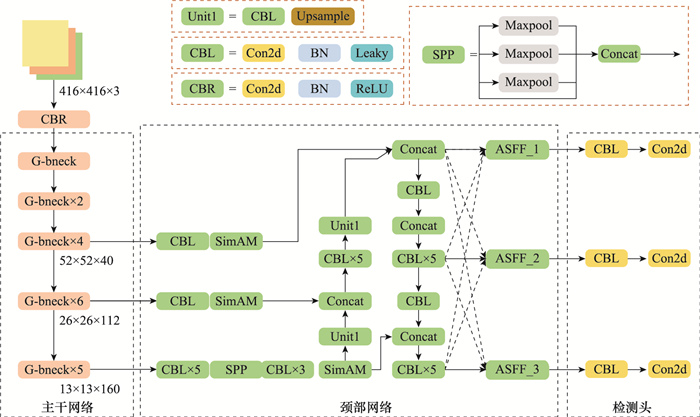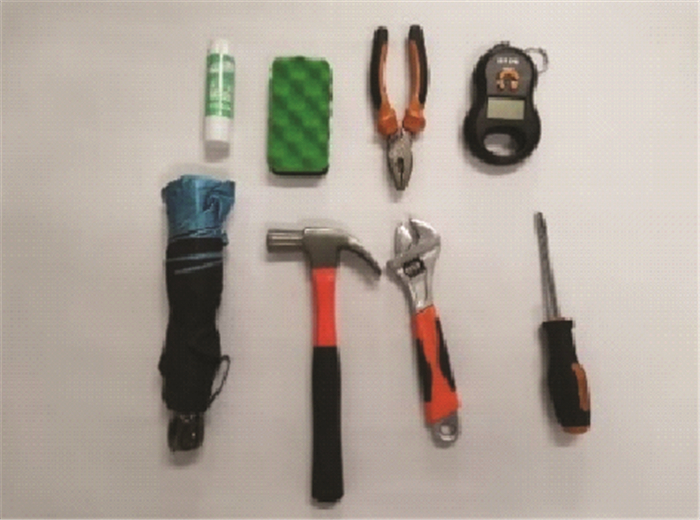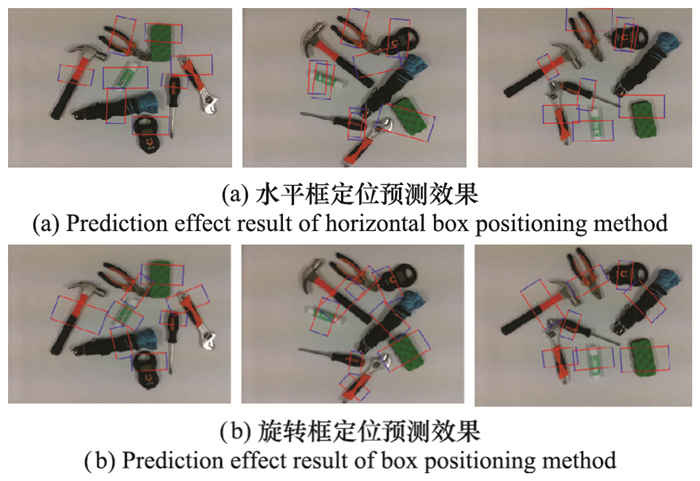Systems Engineering and Electronics ›› 2024, Vol. 46 ›› Issue (6): 1867-1877.doi: 10.12305/j.issn.1001-506X.2024.06.05
• Electronic Technology • Previous Articles
Object grasp pose detection based on the region of interest
Xiantao SUN1, Wangyang JIANG1, Wenjie CHEN1,*, Weihai CHEN2, Yali ZHI1
- 1. School of Electrical Engineering and Automation, Anhui University, Hefei 230601, China
2. School of Automation Science and Electrical Engineering, Beihang University, Beijing 100191, China
-
Received:2023-03-02Online:2024-05-25Published:2024-06-04 -
Contact:Wenjie CHEN
CLC Number:
Cite this article
Xiantao SUN, Wangyang JIANG, Wenjie CHEN, Weihai CHEN, Yali ZHI. Object grasp pose detection based on the region of interest[J]. Systems Engineering and Electronics, 2024, 46(6): 1867-1877.
share this article
| 1 |
CAI J H , CEN J , WANG H K , et al. Real-time collision-free grasp pose detection with geometry-aware refinement using high-resolution volume[J]. IEEE Robotics and Automation Letters, 2022, 7 (2): 1888- 1895.
doi: 10.1109/LRA.2022.3142424 |
| 2 | CHENG H , WANG Y Y , MENG M Q H . A robot grasping system with single-stage anchor-free deep grasp detector[J]. IEEE Trans.on Instrumentation and Measurement, 2022, 71, 5009712. |
| 3 | WEN H T, YAN J H, PENG W L, et al. TransGrasp: grasp pose estimation of a category of objects by transferring grasps from only one labeled instance[C]//Proc. of the 17th European Conference, 2022: 445-461. |
| 4 | WEI H , PAN S C , MA G , et al. Vision-guided hand-eye coordination for robotic grasping and its application in tangram puzzles[J]. Artificial Intelligence, 2021, 2 (2): 209- 228. |
| 5 | LENZ I , LEE H , SAXENA A . Deep learning for detecting robotic grasps[J]. The International Journal of Robotics Research, 2015, 34 (4/5): 705- 724. |
| 6 | MORRISON D , CORKE P , LEITNER J . Learning robust, real-time, reactive robotic grasping[J]. The International Journal of Robotics Research, 2020, 39 (2/3): 183- 201. |
| 7 | LIANG H Z, MA X J, LI S, et al. Pointnetgpd: detecting grasp configurations from point sets[C]//Proc. of the International Conference on Robotics and Automation, 2019: 3629-3635. |
| 8 | ZHANG L Z , WU D M . A single target grasp detection network based on convolutional neural network[J]. Computational Intelligence and Neuroscience, 2021, (5): 5512728. |
| 9 |
CHU F J , XU R N , VELA P A . Real-world multi-object, multi-grasp detection[J]. IEEE Robotics and Automation Letters, 2018, 3 (4): 3355- 3362.
doi: 10.1109/LRA.2018.2852777 |
| 10 | AINETTER S, FRAUNDORFER F. End-to-end trainable deep neural network for robotic grasp detection and semantic segmentation from RGB[C]//Proc. of the IEEE International Conference on Robotics and Automation, 2021: 13452-13458. |
| 11 | 陈丹, 林清泉. 基于级联式Faster RCNN的三维目标最优抓取方法研究[J]. 仪器仪表学报, 2019, 40 (4): 229- 237. |
| CHEN D , LIN Q Q . Research on 3D object optimal grasping method based on cascaded Faster RCNN[J]. Chinese Journal of Scientific Instrument, 2019, 40 (4): 229- 237. | |
| 12 | REN S Q , HE K M , GIRSHICK R , et al. Faster R-CNN: towards real-time object detection with region proposal networks[J]. Advances in Neural Information Processing Systems, 2015, 28, 91- 99. |
| 13 | 孟月波, 黄琪, 韩九强, 等. 基于两阶段的机器人动态多物品定位抓取方法[J]. 激光与光电子学进展, 2023, 60 (6): 288- 297. |
| MENG Y B , HUANG Q , HAN J Q , et al. Robot dynamic object positioning and grasping method based on two stages[J]. Laser & Optoelectronics Progress, 2023, 60 (6): 288- 297. | |
| 14 | 安广琳, 李宗刚, 杜亚江, 等. 基于深度学习的多工件抓取点定位方法[J]. 激光与光电子学进展, 2023, 60 (12): 311- 321. |
| AN G L , LI Z G , DU Y J , et al. Research on multiple workpiece grasping point localization method based on deep learning[J]. Laser & Optoelectronics Progress, 2023, 60 (12): 311- 321. | |
| 15 | BOCHKOVSKIY A, WANG C Y, LIAO H Y M. YOLOv4: optimal speed and accuracy of object detection[C]//Proc. of the IEEE Conference on Computer Vision and Pattern Recognition, 2020. |
| 16 | CHEN L C, ZHU Y K, PAPANDREOU G, et al. Encoder-decoder with atrous separable convolution for semantic image segmentation[C]//Proc. of the European Conference on Computer Vision, 2018: 801-818. |
| 17 |
HE K M , ZHANG X Y , REN S R , et al. Spatial pyramid pooling in deep convolutional networks for visual recognition[J]. IEEE Trans.on Pattern Analysis and Machine Intelligence, 2015, 37 (9): 1904- 1916.
doi: 10.1109/TPAMI.2015.2389824 |
| 18 | LIU S, QI L, QIN H F, et al. Path aggregation network for instance segmentation[C]//Proc. of the IEEE Conference on Computer Cision and Pattern Recognition, 2018: 8759-8768. |
| 19 | LIN T Y, DOLLÁR P, GIRSHICK R, et al. Feature pyramid networks for object detection[C]//Proc. of the IEEE Conference on Computer Vision and Pattern Recognition, 2017: 2117-2125. |
| 20 | HAN K, WANG Y H, TIAN Q, et al. Ghostnet: more features from cheap operations[C]//Proc. of the IEEE/CVF Conference on Computer Vision and Pattern Recognition, 2020: 1580-1589. |
| 21 | CHOLLET F. Xception: deep learning with depthwise separable convolutions[C]//Proc. of the IEEE Conference on Computer Vision and Pattern Recognition, 2017: 1251-1258. |
| 22 | YANG L X, ZHANG R Y, LI L D, et al. Simam: a simple, parameter-free attention module for convolutional neural networks[C]//Proc. of the International Conference on Machine Learning, 2021: 11863-11874. |
| 23 | LIU S T, HUANG D, WANG Y H. Learning spatial fusion for single-shot object detection[C]//Proc. of the International Conference on Computer Vision and Pattern Recognition, 2019. |
| 24 | YANG X, YAN J C, FENG Z M, et al. R3det: refined single-stage detector with feature refinement for rotating object[C]//Proc. of the AAAI Conference on Artificial Intelligence, 2021, 35(4): 3163-3171. |
| 25 | YANG X, YANG J R, YAN J C, et al. SCRDet: towards more robust detection for small, cluttered and rotated objects[C]//Proc. of the IEEE/CVF International Conference on Computer Vision, 2019: 8232-8241. |
| 26 | SELVARAJU R R, COGSWELL M, DAS A, et al. Grad-cam: visual explanations from deep networks via gradient-based localization[C]//Proc. of the IEEE International Conference on Computer Vision, 2017: 618-626. |
| 27 | HAN J M , DING J , LI J , et al. Align deep features for oriented object detection[J]. IEEE Trans.on Geoscience and Remote Sensing, 2021, 60, 1- 11. |
| 28 | YANG X, ZHANG G F, LI W T, et al. H2RBox: horizontal box annotation is all you need for oriented object detection[C]//Proc. of the International Conference on Learning Representations, 2023. |
| 29 | HE K M, ZHANG X Y, REN S Q, et al. Deep residual learning for image recognition[C]//Proc. of the IEEE Conference on Computer Vision and Pattern Recognition, 2016: 770-778. |
| 30 | 李明, 鹿朋, 朱龙, 等. 基于RGB-D融合的密集遮挡抓取检测[J]. 控制与决策, 2023, 38 (10): 2867- 2874. |
| LI M , LU P , ZHU L , et al. Densely occluded grasping objects detection based on RGB-D fusion[J]. Control and Decision, 2023, 38 (10): 2867- 2874. |
| [1] | Xuemei CHEN, Zhiheng LIU, Suiping ZHOU, Hang YU, Yanming LIU. Road extraction from high-resolution remote sensing images based on HRNet [J]. Systems Engineering and Electronics, 2024, 46(4): 1167-1173. |
| [2] | Tianwen ZHANG, Xiaoling ZHANG, Zikang SHAO, Tianjiao ZENG. Mask attention interaction for SAR ship instance segmentation [J]. Systems Engineering and Electronics, 2024, 46(3): 831-838. |
| [3] | Duanyang SHI, Qiang LIN, Bing HU, Xiaoshuai DU. Target detection method of primary surveillance radar based on YOLO [J]. Systems Engineering and Electronics, 2024, 46(1): 143-151. |
| [4] | Meng WANG, Bing ZHU. Application of uncertainty modeling in 2D and 3D object detection [J]. Systems Engineering and Electronics, 2023, 45(8): 2370-2376. |
| [5] | Kai SHAO, Ziqun DU, Guangyu WANG. CSI feedback method for dynamically adjusting compression rate based on model pruning [J]. Systems Engineering and Electronics, 2023, 45(8): 2615-2622. |
| [6] | Tianshu CUI, Dong WANG, Zhen HUANG. Automatic modulation classification based on lightweight network for space cognitive communication [J]. Systems Engineering and Electronics, 2023, 45(7): 2220-2226. |
| [7] | Yu JIANG, Qi YUAN, Zhitao HU, Weiwei WU, Xin GU. Airport arrival and departure delay time prediction based on meteorological factors [J]. Systems Engineering and Electronics, 2023, 45(6): 1722-1731. |
| [8] | Yang CHEN, Canhui LIAO, Kun ZHANG, Jian LIU, Pengju WANG. A signal modulation indentification algorithm based on self-supervised contrast learning [J]. Systems Engineering and Electronics, 2023, 45(4): 1200-1206. |
| [9] | Ye ZHANG, Yi HOU, Kewei OUYANG, Shilin ZHOU. Survey of univariate sequence data classification methods [J]. Systems Engineering and Electronics, 2023, 45(2): 313-335. |
| [10] | Zhengtu SHAO, Dengrong XU, Wenli XU, Hanzhong WANG. Radar active jamming recognition based on LSTM and residual network [J]. Systems Engineering and Electronics, 2023, 45(2): 416-423. |
| [11] | Renfei CHEN, Yong PENG, Zhongwen LI. A novel detector for floating objects based on continual unsupervised domain adaptation strategy [J]. Systems Engineering and Electronics, 2023, 45(11): 3391-3401. |
| [12] | Chensong TAO, Siwei CHEN, Shunping XIAO. SAR image interrupted sampling repeater jamming detection based on deep learning models [J]. Systems Engineering and Electronics, 2023, 45(11): 3465-3473. |
| [13] | Shiyang HE, Ling WANG, Daiyin ZHU, Jun QIAN. Thunderstorm prediction method based on spatiotemporal memory decoupling RNN [J]. Systems Engineering and Electronics, 2023, 45(11): 3474-3480. |
| [14] | Haoran LI, Wei XIONG, Yaqi CUI. An association method between SAR images and AIS information based on depth feature fusion [J]. Systems Engineering and Electronics, 2023, 45(11): 3491-3497. |
| [15] | Zichao LIU, Jiang WANG, Shaoming HE. Time and angle control guidance law based on deep learning [J]. Systems Engineering and Electronics, 2023, 45(11): 3579-3587. |
| Viewed | ||||||
|
Full text |
|
|||||
|
Abstract |
|
|||||

































